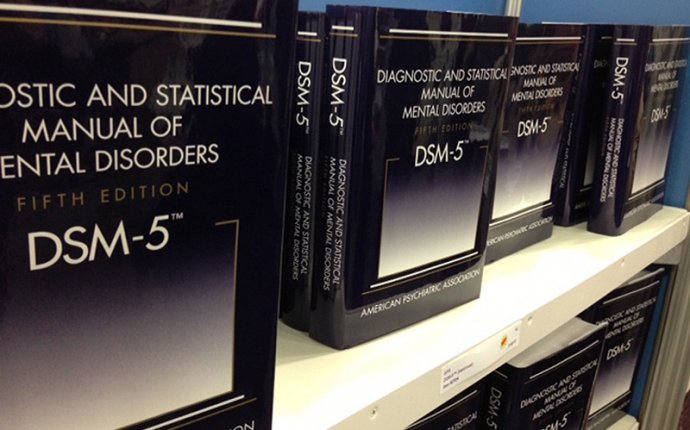
list of mental Syndromes
The DSM-5, scheduled for publication in 2013, will be the latest version of the American Psychiatric Association's Diagnostic and Statistical Manual of Mental Disorders. Note: This chart lists major disorders only and is not meant to be comprehesive. See also: Personality Disorder Symptoms
Description
A - Neurodevelopmental Disorders A05 299.00Autism
The three main characteristics of autism are: 1. impaired social development, 2. diminished communication skills, and 3. restrictive/repetitive behavior. The disorder is highly variable and is now described in terms of a spectrum rather than a set of discrete categories. For example, Asperger's, once classified separately, is now considered by many experts to be a form of high-functioning autism. Males are 4 times more likely to be autistic than females. A06 314.00ADHD
ADHD (formerly known as ADD) stands for Attention Deficit Hyperactivity Disorder and in most cases is characterized by: 1. a difficulty in focusing one's attention on a single task, and 2. a tendency towards hyperactivity and impulsive behaviors (although some individuals are either predominantly inattentive or predominantly hyperactive-impulsive). Ritalin, a stimulant, is well known as being a common drug used to treat ADHD, particularly in children. A08 315.00Dyslexia
Dyslexia is a very broad term defining a learning disability that impairs a person's ability to read. It is not connected in any way with intelligence. A11 307.23Tourette's
Tourette's is characterized by sudden urges to engage in a repetitive behavior (called a tic) such as blinking one's eyes or smacking one's lips . Although usually associated with uncontrollable swearing, this form of the disorder (known as Coprolalia) is actually quite rare. B - Psychotic Disorders B08 295.00Schizophrenia
Schizophrenia is a serious mental illness characterized by auditory hallucinations, paranoia, bizarre delusions, and/or disorganized thinking. It should not be confused with multiple personality disorder (now called dissociative identity disorder), described below. C, D - Mood Disorders C00 296.50Bipolar Disorder
Previously known as Manic-Depression, bipolar disorder is characterized by episodes of significantly elevated mood, arousal, and/or energy levels (mania) often interspersed with contrasting episodes of low mood (depression). It is often noted that there is a significant association between bipolar disorder and creativity D02 296.30Clinical
Depression
Also known as Major Depressive Disorder or Unipolar Depression, this type of recurrent depression is characterized by an all-encompassing low mood, diminished self-esteem, and a loss of interest in normally enjoyable activities. Often misunderstood as being something that individuals should be able to overcome by will-power alone, major depression often requires antidepressant medication such as an SSRI (Selective Serotonin Reuptake Inhibitor).
E, F, G - Anxiety Disorders
E01
300.01
Panic Disorder
A panic attack is a short period (usually 5-10 minutes) of intense fear that comes on suddenly and is characterized by symptoms such as an increased heart rate, shortness of breath, dizziness, numbness, and changes in body temperature. Individuals with panic disorder have recurring panic attacks and often the fear of the attacks themselves become the focus of their anxiety. Panic Disorder often occurs together with Agoraphobia (E02), the fear of public places. E03 300.29Phobias
A phobia is a persistent fear of a certain object or situation in which the individual goes to great lengths to avoid the object or situation in a way that is irrational and disproportional to the actual danger posed. Common phobias include a fear of insects, dogs, boats, needles, airplanes, elevators, etc.). Social Anxiety Disorder (E04) is a special type of phobia in which the individual has an extreme fear of social interaction. E05 300.02Generalized
Anxiety Disorder
Generalized Anxiety Disorder (often shortened to GAD) is characterized by disproportionate worry about everyday things (such as money, health, or relationships) that is ongoing and uncontrollable. It is often expressed in the form of headaches, fidgeting, nausea, irritability, fatigue, or insomnia.
F00
300.30
OCD
OCD stands for Obsessive-Compulsive Disorder and is characterized by uncontrollable thoughts (obsessions) that lead to repetitive behaviors (compulsions) aimed at relieving the anxiety brought on by those thoughts. Common compulsions include excessive handwashing, repeated checking, nervous rituals, or extreme hoarding. Unlike those with Obsessive-Compulsive Personality Disorder (OCPD), individuals with OCD often recognize that their obsessions are irrational and therefore experience greater anxiety and feelings of helplessness. G03 309.81PTSD
PTSD stands for Post-traumatic Stress Disorder and can develop after exposure to extreme trauma such as sexual abuse, physical assault, or certain wartime experiences. Symptoms include flashbacks, nightmares and hypervigilance. Prolonged exposure to trauma in which there was no viable means of escape can lead to a distinct but related disorder known as Complex Post-traumatic Stress Disorder (C-PTSD) H - Dissociative Disorders H00 300.60Depersonalization
Disorder
Depersonalization Disorder is characterized by frequent feelings of detachment from oneself combined with an awareness of the detachment. To someone experiencing depersonalization, the external world feels strange and unreal and a person can even get the sense that they are watching themselves from a third person perspective. However, unlike in psychosis, the individual remains very much aware of their own existence and is, in fact, overly aware of it. For this reason, depersonalization disorder is often associated with the philosophy of existentialism.
H02
300.14
Dissociative
Identity Disorder
 Formerly known as Multiple Personality Disorder (MPD), Dissociative Identity Disorder (DID) is a controversial diagnosis in which an individual has two or more distinct personalities, each with their own memories and patterns of behaviour. The development of these multiple personalities is a coping mechanism caused by extreme trauma or abuse at an early age (prior to when a sense of a unitary self forms).
J - Somatic Disorders
J01
300.70
Formerly known as Multiple Personality Disorder (MPD), Dissociative Identity Disorder (DID) is a controversial diagnosis in which an individual has two or more distinct personalities, each with their own memories and patterns of behaviour. The development of these multiple personalities is a coping mechanism caused by extreme trauma or abuse at an early age (prior to when a sense of a unitary self forms).
J - Somatic Disorders
J01
300.70
Illness Anxiety Disorder
A person who suffers from Illness Anxiety Disorder is commonly known as a hypochondriac. Such as person constantly worries about their health even when they have no reason to do so and often any minor symptom is perceived as being a...
Source: www.psychologycharts.com









